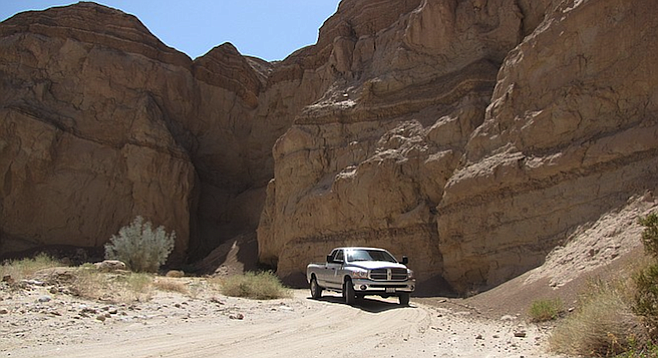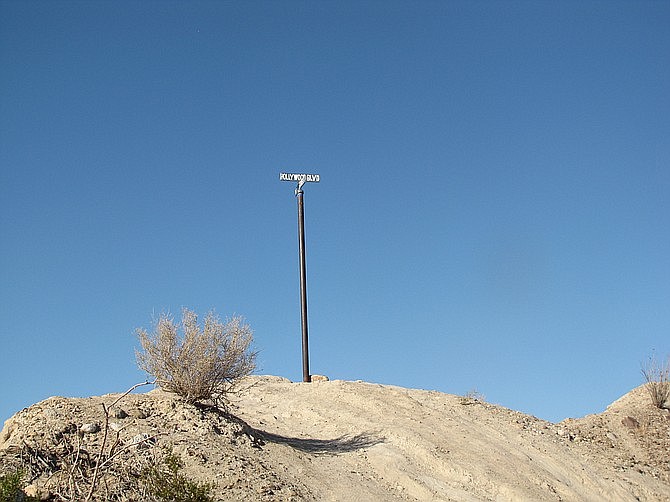 Facebook
Facebook
 X
X
 Instagram
Instagram
 TikTok
TikTok
 Youtube
Youtube

Mud walls towered over us as we twisted and turned down the narrow canyon. Smoke trees scraped the truck where they leaned in over the rutted track, and a couple of times there was a sharp metallic sound when the truck couldn’t quite ease past a protruding rock. We were having a blast!
We had started down a known canyon in Anza-Borrego Desert State Park. It was Canyon Sin Nombre – “canyon without a name.” We’d been down the canyon before and were back to enjoy the unique geologic displays dating from three to five million years ago. Driving in the canyon was easy; it was relatively wide, and after a short distance it opened up into a sandy wash that offered multiple routes around trees and over the few rocky stretches.
Of course, I had my head buried in the 4WD guidebook and failed to see the side road we should have turned on to keep the trip an easy one.

Instead of the wide roadstead we expected, we had entered a canyon that got progressively narrower. The walls started as high as the truck and soon became cliffs that loomed over us several times our height. The eroded mud walls began to close in on us and we realized our mistake, but there was no turning back without tight maneuvering; besides, we were enjoying the new terrain.
Studying the map, we determined we had entered a canyon called Arroyo Seco del Diablo – the devil’s dry wash. About five miles ahead we had two ways to get out. One was the Diablo Drop-Off, which the book cautioned should be attempted only by VERY experienced 4WD drivers in specially outfitted vehicles.
The other choice was Arroyo Tapiado. Rather than being narrow, twisting and difficult, it was described as a broad wash that led to a section of eroded clay hills riddled with mud caves.
But our challenge was to find Tapiado without getting lost somewhere in Diablo. The good news was that there weren’t (or shouldn’t be) many turn-offs from the Devil's canyon. All we had to do as I understood it was ignore any road to the right, which would lead directly to the Drop Off, and stick to the left until we found ourselves 180 degrees from our current direction. Of course, figuring out a 180-degree deviation when each turn of the canyon takes you anywhere from 20 to 90 degrees in some other direction isn’t exactly intuitive. That’s when we started paying serious attention to mileage and compass direction.
We knew when we had arrived at the Devil’s Drop-Off. The road was full of really serious looking 4WD’ers with gnarly rigs. They weren’t the casual four-wheeler like us in our production Dodge long-bed truck that struggled around tight corners. Shortly after passing them we did one steep drop and found ourselves heading south once again. Look out caves, here we come!
It was getting late in the day after our unintended detour, so we didn’t stop to inspect the caves. That would have to be another day when we explored Tapiado Canyon on purpose.

We finally found our intended exit route – Vallecito Creek – and started down the final leg of our backcountry trek. We drove past the whimsical Hollywood and Vine street sign (left) high atop a sandy ridge about 150 miles from the real intersection, and – now back on our first paved road in over four hours – across the entrance to Fossil Canyon, where they're still finding artifacts from seven million years ago.
It was a great day, although we pledged never to take that oversized Dodge up Arroyo Seco del Diablo again. There are plenty of other canyons we can explore without some of the sound effects we had on this trip.
Here are a couple resources that might help you plan your route:


Mud walls towered over us as we twisted and turned down the narrow canyon. Smoke trees scraped the truck where they leaned in over the rutted track, and a couple of times there was a sharp metallic sound when the truck couldn’t quite ease past a protruding rock. We were having a blast!
We had started down a known canyon in Anza-Borrego Desert State Park. It was Canyon Sin Nombre – “canyon without a name.” We’d been down the canyon before and were back to enjoy the unique geologic displays dating from three to five million years ago. Driving in the canyon was easy; it was relatively wide, and after a short distance it opened up into a sandy wash that offered multiple routes around trees and over the few rocky stretches.
Of course, I had my head buried in the 4WD guidebook and failed to see the side road we should have turned on to keep the trip an easy one.

Instead of the wide roadstead we expected, we had entered a canyon that got progressively narrower. The walls started as high as the truck and soon became cliffs that loomed over us several times our height. The eroded mud walls began to close in on us and we realized our mistake, but there was no turning back without tight maneuvering; besides, we were enjoying the new terrain.
Studying the map, we determined we had entered a canyon called Arroyo Seco del Diablo – the devil’s dry wash. About five miles ahead we had two ways to get out. One was the Diablo Drop-Off, which the book cautioned should be attempted only by VERY experienced 4WD drivers in specially outfitted vehicles.
The other choice was Arroyo Tapiado. Rather than being narrow, twisting and difficult, it was described as a broad wash that led to a section of eroded clay hills riddled with mud caves.
But our challenge was to find Tapiado without getting lost somewhere in Diablo. The good news was that there weren’t (or shouldn’t be) many turn-offs from the Devil's canyon. All we had to do as I understood it was ignore any road to the right, which would lead directly to the Drop Off, and stick to the left until we found ourselves 180 degrees from our current direction. Of course, figuring out a 180-degree deviation when each turn of the canyon takes you anywhere from 20 to 90 degrees in some other direction isn’t exactly intuitive. That’s when we started paying serious attention to mileage and compass direction.
We knew when we had arrived at the Devil’s Drop-Off. The road was full of really serious looking 4WD’ers with gnarly rigs. They weren’t the casual four-wheeler like us in our production Dodge long-bed truck that struggled around tight corners. Shortly after passing them we did one steep drop and found ourselves heading south once again. Look out caves, here we come!
It was getting late in the day after our unintended detour, so we didn’t stop to inspect the caves. That would have to be another day when we explored Tapiado Canyon on purpose.

We finally found our intended exit route – Vallecito Creek – and started down the final leg of our backcountry trek. We drove past the whimsical Hollywood and Vine street sign (left) high atop a sandy ridge about 150 miles from the real intersection, and – now back on our first paved road in over four hours – across the entrance to Fossil Canyon, where they're still finding artifacts from seven million years ago.
It was a great day, although we pledged never to take that oversized Dodge up Arroyo Seco del Diablo again. There are plenty of other canyons we can explore without some of the sound effects we had on this trip.
Here are a couple resources that might help you plan your route: